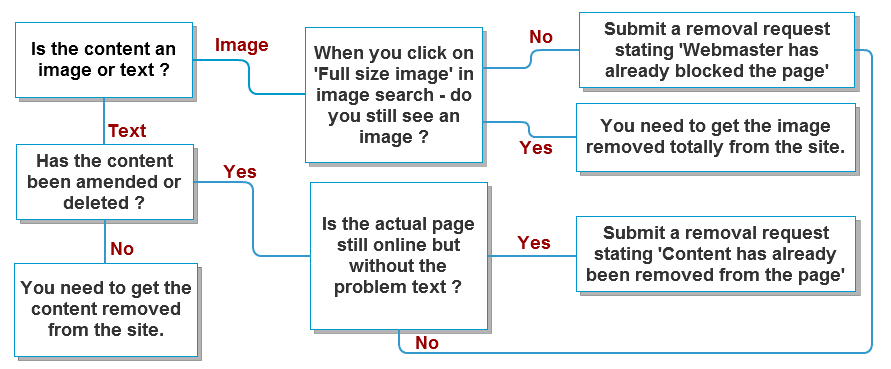What type of removal request should I submit ?
One of the biggest causes of failed removal requests is submitting the wrong type of request. Before you proceed, understand the difference between the options offered by the removal tool so that your request has more chance of success the first time.
The main request types are page removals and cache removals. (Other requests types are directory removals, site removals and safe search removals)
Follow the paths in the chart below to see an overview
NB: In the above flowchart, the box mentioning clicking 'Full size image' needs to be amended to reflect the current Google Image search results. The full size image will be reached by clicking the Share button, copying the goo.gl url and accessing that goo.gl url and then copying the image url by right-clicking it. A bit roundabout, but effective nonetheless.
Cache removals
Cache removals only remove the snippet shown under the title and the cached page which can be seen if you click on the ‘cache’ link in the search result. This does not remove or stop the entry from appearing in search results, it will appear anyway, but minus the search snippet and the cache.
- Cache removals are appropriate when the page which holds the content you want removing is still live or forwards to a live url.
- For a cache removal the content would need to have been amended or removed in some way since the page was last crawled by Google.
- This does not apply to non-html (or plain text) content like images or pdfs, you cannot request a cache removal for these; they need to be blocked or removed totally or await a recrawl.
- When submitting, choose the second option ‘The page has changed and Google’s cached version is out of date‘
- If you are unsure about the actual process you can read more about submitting a cache removal request.
Page removals
This will remove the whole page from appearing. This is always the better option, if the criteria for removal are met. This procedure may also be sued to request removal of other types of indexed documents, such as pdf, Word documents, Excel spreadsheets, xml files, txt files, etc.
- Page removals are to be used when the whole page has either beed deleted from the website (i.e. it responds with a 404 or 410) or been blocked (with a Disallow directive in robots.txt or with a robots noindex meta tag (for an html document) or an x-robots-tag set to noindex) so that it meets Google’s criteria for removal.
- You can check the page status on this site or ask on the Webmaster forum if you are not sure.
- When submitting, choose the first option ‘Page has been removed or blocked from search engines‘.
- If you are unsure about the actual process you can read more about submitting a url removal request.
Before you submit a request
Check to see whether you are requesting the correct option. If the page has
been blocked in a way suitable to Google then you should request a page removal.
NB: A cache removal does not apply to pdf documents, nor to images or any non-text based files. Note that an Excel document (e.g. .xls ) is not text-based, but a .csv file is text based.
If the page is not eligible for removal then you might be able to submit a cache removal. Whilst this does not remove the page, it can reduce the visibility in search results until it is naturally recrawled. But some content on the page must have been modified since the last time it was cached and you need to identify a single unique word which was (in the webcache) but is no longer present on the live page.

